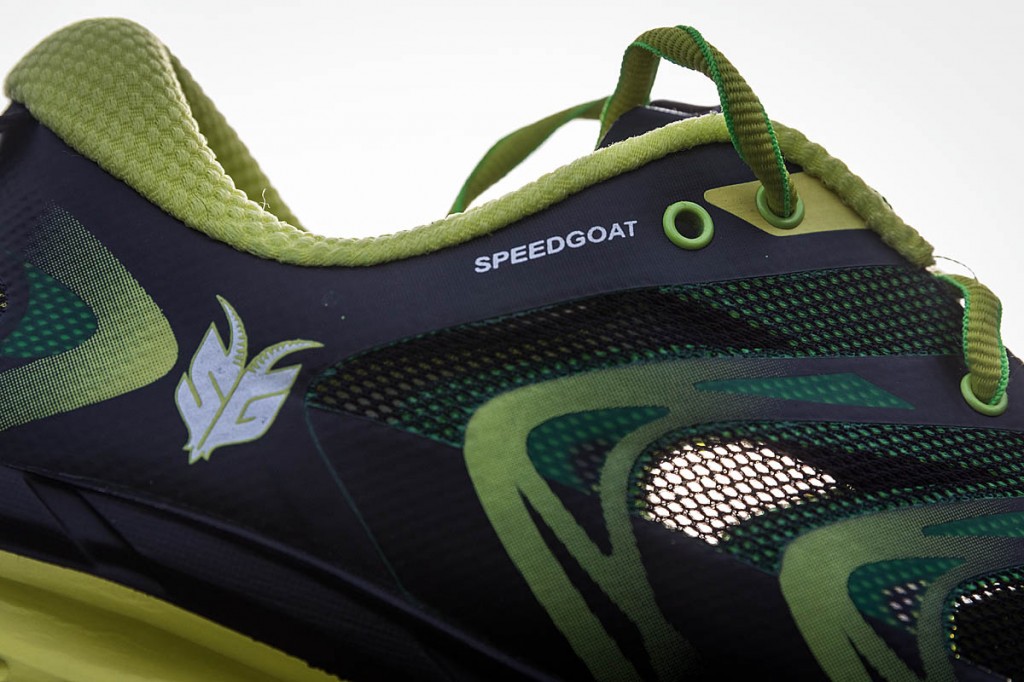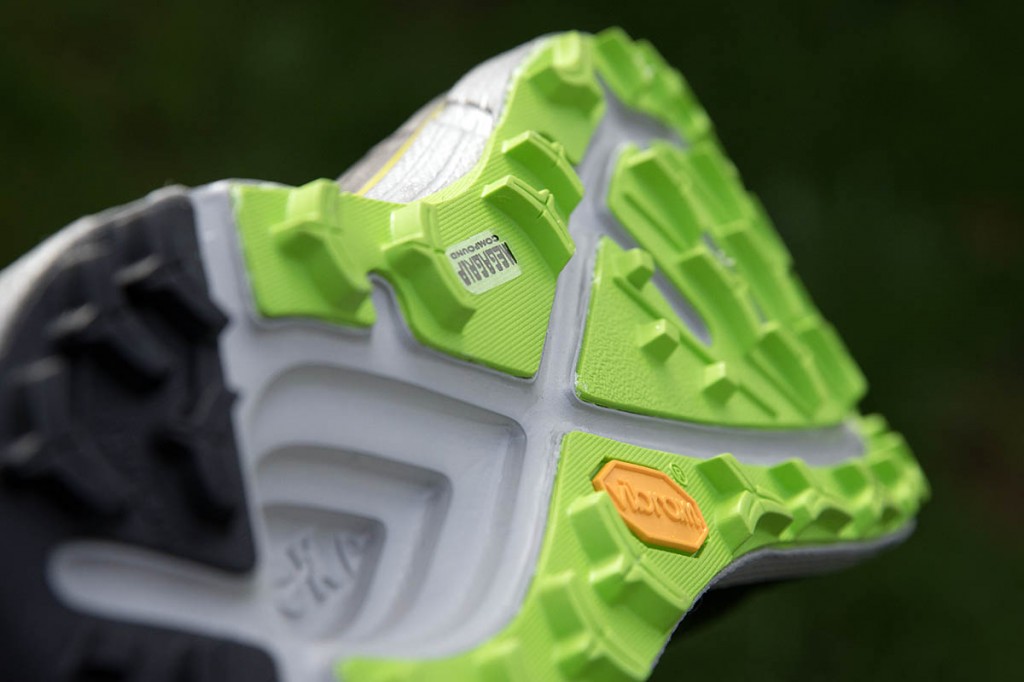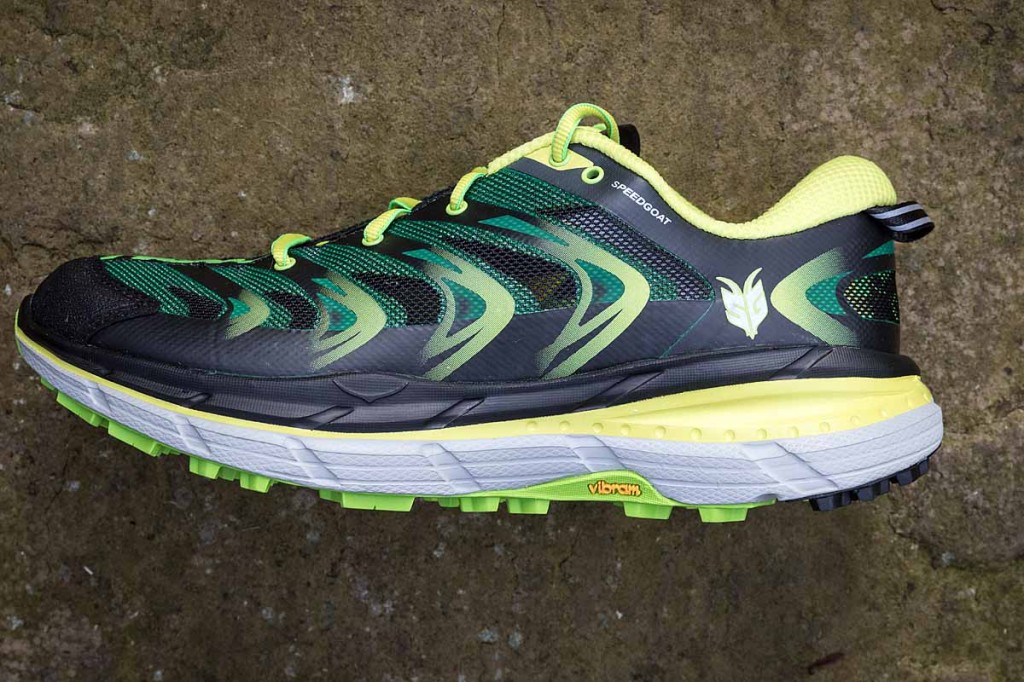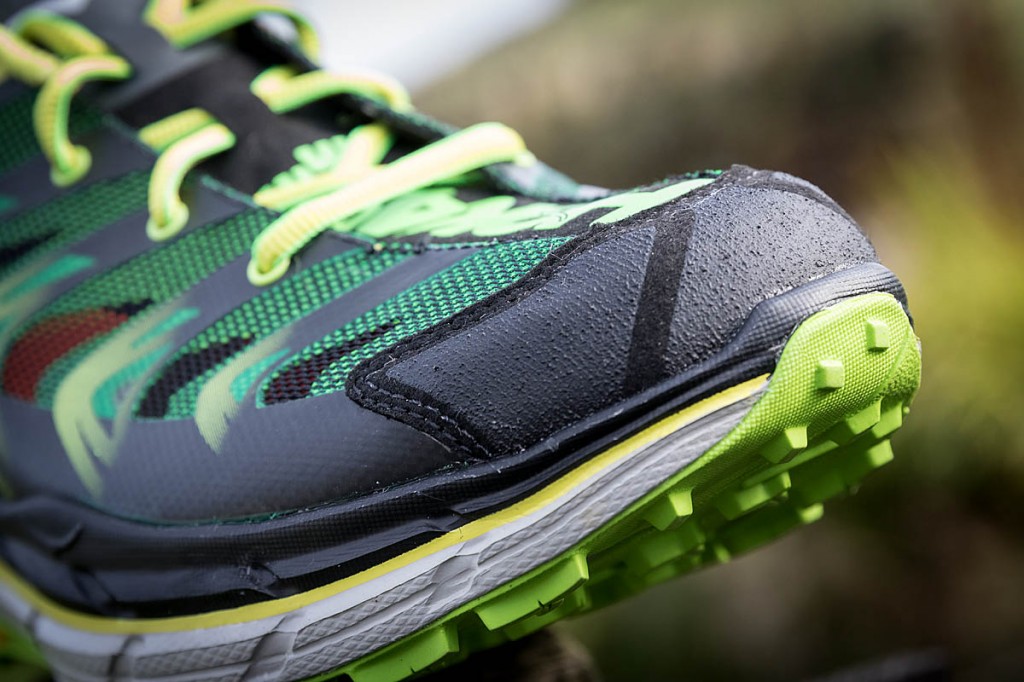Price: £120
Colour: black/green
Weight: 582g/pair (size 9)
Construction: fabric/synthetic uppers/Vibram outsole
Waterproofing: none
Country of manufacture: Vietnam
Sole stiffness: 2/10
Sizes: men’s 6½-13½ (40-49⅓); women’s 3½-9½ (36-44)
The curious name of these trailrunning shoes comes from the Utah skyrunning race organised by Karl Meltzer and his input is also central to the design of this footwear.
The first noticeable aspect of the Speedgoats is Hoka One One’s customary thick soles.
The outsole is a very grippy Vibram unit with 4mm lugs. The very rear heel unit is in different coloured rubber which feels very slightly more durable than the main section. There is a pronounced rocker shape to the whole sole unit with both the heel and toe areas rising markedly.
There is a deep indentation in the heel outsole, meaning the heel of the foot effectively rides on a sort of horse-shoe shape, with only the outer areas making contact with the ground.
Traction and braking were very good on our test trail surfaces, which include rock, gravel, grass and mud, with performance very assured and a little slipping only noticeable on the greasiest of surfaces and very soft mud.
There is a small toe extension upwards of the outsole at the front of the shoe, which helped with grip on steeper rock.
The Speedgoat has a large amount of underfoot cushioning from the thick EVA midsole. The heel has a 33mm height and the forefoot 28mm. On the trail, we found the foot planted firmly on the mid-to forefoot area with each running step, and shock absorption was excellent, indicating good comfort over long-distance routes.
The insole is a fairly basic Ortholite unit with a little more padding at the heel cup than in the forefoot.
The uppers combine tough-feeling mesh with a bonded-on Speedframe, a plastic skeleton applied both externally and internally, which gives the foot plenty of support. The toe has a rubber section that provides some protection from rocks, though it’s fairly soft. A slightly raised rand keeps out the water in very shallow puddles, but you will certainly get wet feet if running in rain or passing through pools, mud or wet grass.
The mesh does allow fairly rapid drying out of the foot, and during wet-dry-wet outings we could feel the mesh working well. Even when wet, our feet felt quite warm in the Speedgoats.
The lacing, with four pairs of eyelets, ends fairly well back from the toe section and it’s hard to pull in the instep section of the uppers, which are surprisingly rigid in that area. The flattish-section laces locked adequately and there is an extra top eyelet a little further back for those who want to adjust lacing at the very top of the shoe.
The tongue has just a little padding, but there is a good amount of foam around the ankle and heel, which also helped keep out gravel. The mesh of the uppers did allow a few very small pieces of grit into the shoe in muddy areas.
Sizing was slightly on the small side, probably by about a third of a UK size. The Speedgoats are fairly roomy in the heel and mid-foot area, but narrow noticeably at the forefoot and toe. We could feel the pressure particularly on the outside of the forefoot and a little pinching at the toe. Careful lacing was necessary to prevent exacerbating this on downhill sections of our test routes.
We tested the Hoka shoes both for running and lightweight walking on our test routes. The Speedgoats weigh less than 600g a pair and provided good comfort on a variety of surfaces. We found stability was good despite the fairly high sole and underfoot shock absorption was very good. Hoka say the Speedgoats are designed for trailrunning on technical terrain and they performed well in this environment. The soles provided good protection underfoot from rocks, and the grip was very good.
The Hoka One One shoes can also be used happily on less technical surfaces.
We recommend trying on the Speedgoats to test for fit. For those with a wider forefoot, the narrow fit in that area may mean they shoes are not the most comfortable for them. Despite that, the snug fit of the shoes did prevent movement of the foot on the running trail, once a good lacing set-up was found.
Performance 25/30
Comfort 23/30
Versatility 7/10
Quality 7/10
Value for money 15/20
Total score: 77/100
The shoes were supplied to grough by Hoka One One.



